Introduction to the Importance of E-commerce Website Design in the Digital Age
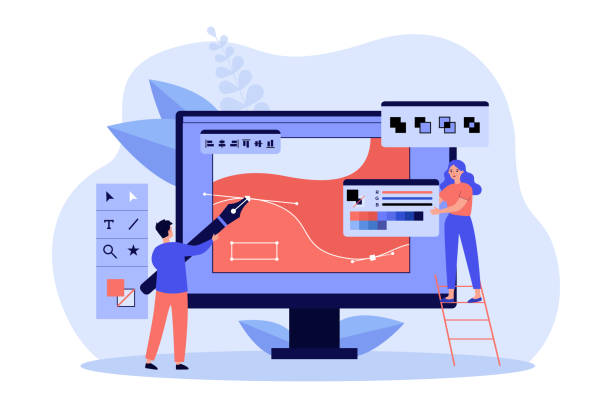
In today’s world, where information and communication technology is advancing at a breathtaking pace, having a strong online presence is no longer an option, but a necessity.
The digital age has increasingly dominated our daily lives and completely transformed how products and services are bought and sold.
Therefore, #e-commerce_website_design has become one of the most important pillars of success in #e-commerce.
One can no longer rely solely on a physical store, as customers seek convenience, speed, and 24/7 access.
An e-commerce website allows businesses to reach a much broader market than a physical store can offer.
This means access to customers across the country and even the world, without geographical and time limitations.
The growing trend of online shopping, which has accelerated with recent pandemics, shows that consumers are more willing than ever to meet their needs through the internet.
Therefore, investing in professional web design for an online sales platform is not only a strategic move but an essential step for survival and growth in today’s competitive market.
This is especially vital for small and medium-sized businesses to compete alongside industry giants and gain their share of the online market.
A suitable e-commerce site can help you build your brand, gain customer trust, and provide them with a unique shopping experience.
In the rest of this article, we will comprehensively explore various aspects of e-commerce website design and key tips for launching a successful online store.
Are you frustrated with your online store’s low conversion rate?
Rasaweb, with its professional e-commerce website design, is your definitive solution!
✅ Increase your sales and revenue
✅ Unparalleled user experience for your customers
⚡ Get a free consultation now!
Initial Planning Stages for Launching an Online Store
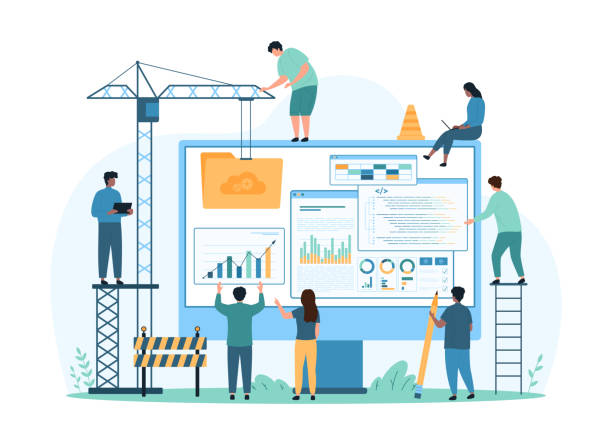
Before any practical action to build an online store, thorough and comprehensive planning is of paramount importance.
This stage involves precise analysis and examination of various aspects of your business and target market.
The first step is to accurately identify your business’s position and niche; you need to determine what products or services you offer and how you differentiate from your competitors.
This clarity in identification helps you make your marketing strategies more targeted.
Next, it’s time to gain a deep understanding of your target audience.
Who are your customers? What are their needs, interests, purchasing habits, and demographics? The more you know about your customers, the better you can optimize your website and products for them.
Developing a strong Business Plan, including goals, strategies, financial forecasts, and competitor analysis, defines your path forward.
Competitive analysis is also crucial at this stage; you need to know what your competitors are doing, their strengths and weaknesses, and how you can differentiate yourself from them.
This analysis can include examining their websites, pricing strategies, marketing campaigns, and even their customer services.
Finally, the selection of the appropriate platform for e-commerce website design also takes place in this initial phase.
Will you use a ready-made content management system like WooCommerce or Shopify, or are you looking for a custom solution? Each has its own advantages and disadvantages that should be considered based on your budget, required scalability, and existing technical knowledge.
Precise planning at this stage prevents wasted time and resources in subsequent stages and significantly increases your chances of success.
Choosing the Right Platform for E-commerce Website Design
![]()
One of the key decisions in the e-commerce website design process is choosing the right platform.
This choice directly impacts your website’s costs, capabilities, security, and ease of management.
There are various platforms available in the market, each offering its unique features and benefits.
WooCommerce, as a powerful plugin for WordPress, is very popular; this platform offers high flexibility and thousands of extensions, making it suitable for businesses with diverse needs, and you will have full control over your site, but it requires more technical knowledge for setup and maintenance.
Shopify is a SaaS (Software as a Service) platform that is quick and easy to set up and is very suitable for individuals without deep technical knowledge, but you will have less control over the code and appearance of the site and it has fixed monthly costs.
Other platforms like OpenCart, PrestaShop, and Magento are also powerful options, each offering different advantages for specific types of businesses, considering budget and specific needs.
Magento is suitable for large and complex stores with high customization needs, while OpenCart and PrestaShop can be good options for medium-sized businesses.
When choosing a platform, you should consider factors such as initial and monthly costs, scalability features, customization options, ease of use, technical support, and user community.
Also, ensure that your chosen platform supports your required payment and shipping methods and provides the necessary tools for SEO and marketing.
This decision should be made carefully and after a thorough review of all aspects to provide a strong foundation for your online store.
| Feature | WooCommerce | Shopify | Magento |
|---|---|---|---|
| Platform Type | Open-Source | SaaS (Software as a Service) | Open-Source |
| Ease of Setup | Medium (requires hosting and WordPress) | Very Easy | Complex (requires high technical knowledge) |
| Cost | Low (hosting and plugins) | Medium (monthly subscription) | High (implementation and maintenance) |
| Customization | High (open source and many plugins) | Medium (themes and apps) | Very High (fully customizable) |
| Scalability | Medium to High | High | Very High (for enterprise) |
UI/UX Design in Online Stores

One of the most important factors in the success of an e-commerce website is its User Experience (UX) and User Interface (UI).
An attractive and visual User Interface (UI) and a smooth and enjoyable User Experience (UX) can determine the difference between a successful online store and a failed one.
UI design relates to the website’s appearance, colors, fonts, images, and how elements are displayed, while UX design focuses on ease of use, navigation logic, loading speed, and the overall feeling of the user when interacting with the site.
The main goal in UX design for an online store is to make the purchasing process as simple, fast, and enjoyable as possible.
This includes designing intuitive navigation that allows customers to easily find their desired products, complete payment steps without confusion, and receive sufficient information about products.
Website responsiveness (Mobile Responsiveness), meaning that your site displays correctly on all devices including mobile, tablet, and desktop, is an absolute requirement today.
A significant portion of website traffic comes from mobile, so mobile optimization is of particular importance.
Using high-quality images, clear and convincing product descriptions, and clear and visible Call to Action buttons are other important principles in UI/UX design.
Also, website page loading speed directly impacts user experience and site ranking in search engines.
A user-centric and optimized design can significantly increase your store’s conversion rate and encourage customers to return.
Do not forget that the main goal in e-commerce website design is sales, and a good user experience directly contributes to this goal.
Research shows that 80% of customers trust companies with professional websites more. Does your current website inspire this trust?
With Rasaweb’s corporate website design services, permanently solve the problem of customer distrust and a weak online image!
✅ Create a professional image and increase customer trust
✅ Attract more sales leads and grow your business
⚡ Get a free consultation now!
Vital Tools for the Success of an E-commerce Website
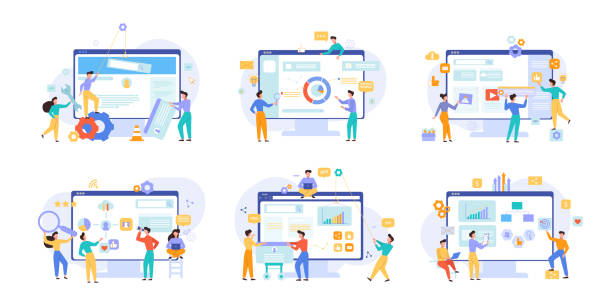
For an e-commerce website design to succeed and achieve successful sales, merely having an appealing appearance is not enough; it requires leveraging a set of supporting tools and systems.
These tools help optimize business processes and enhance customer experience.
One of the most important of these tools is online payment gateways, which enable receiving payments from customers.
Choosing a secure and reliable payment gateway that supports common bank cards in Iran is crucial.
Shipping and logistics systems are also of high importance; integration with postal or courier companies, order tracking, and informing customers about delivery status are all effective in improving the customer experience.
Customer Relationship Management (CRM) system is a tool that helps you record and manage customer information, purchase history, interactions, and needs.
This allows you to establish better relationships with customers, provide personalized services, and execute more targeted marketing campaigns.
Web analytics tools like Google Analytics provide valuable data about site visitors, their behavior, popular pages, traffic sources, and conversion rates.
Analyzing this data is essential for continuous optimization of site performance and identifying strengths and weaknesses.
Also, SEO tools are very important for improving your site’s ranking in search engines and attracting organic traffic.
These tools help you identify suitable keywords, optimize site structure, and produce quality content.
In addition to these, email marketing and marketing automation tools are also essential for maintaining customer relationships and executing effective sales campaigns.
Intelligent use of these tools increases your store’s operational efficiency and ultimately contributes to sales growth.
Content and Marketing for Customer Acquisition in an Online Store

After completing e-commerce website design, the next crucial step is attracting customers and converting them into loyal buyers.
This requires a strong and multifaceted content and marketing strategy.
Quality content is the foundation of any successful online store.
Product descriptions should be comprehensive, accurate, and convincing.
In addition to technical features, the product’s benefits for the customer and how it solves their problems should be addressed.
Using high-quality and professional images and videos of products has a tremendous impact on the customer’s purchase decision.
Images should be shown from various angles, with sufficient detail, and if necessary, with a model, so that the customer has a complete view of the product.
Blogging and producing content related to your industry and products not only helps with SEO and attracting organic traffic but also establishes you as a reliable authority in your field.
This content can include educational articles, buying guides, product reviews, and industry news.
Search Engine Optimization (SEO) is also essential for your site’s visibility in Google search results.
This includes using appropriate keywords, optimizing site structure, loading speed, and acquiring quality backlinks.
Social Media Marketing is also a great way to directly connect with customers, build a community of followers, and introduce new products.
Paid advertising on Google (Google Ads) and social media can also quickly increase traffic and sales, but it requires careful budget management and smart targeting.
Finally, Email Marketing, through sending newsletters, discounts, and special offers to customer email lists, is one of the most effective ways to maintain contact and encourage repeat purchases.
A combination of these strategies will ensure the success of your online store.
Security and Maintenance of an E-commerce Website

Security in e-commerce website design is not just a feature, but an absolute necessity.
In today’s world, where cyber threats are increasing, protecting customer information and preventing data breaches is of vital importance.
A security breach can severely damage your brand’s reputation and lead to loss of customer trust and even legal consequences.
The first step in ensuring security is using an SSL (Secure Sockets Layer) certificate.
This certificate encrypts information exchanged between the user and the website, ensuring that sensitive data such as credit card details are transmitted securely.
Regular maintenance and updating of the platform, plugins, and website themes are also very important.
Developers constantly release security patches to fix vulnerabilities, and failure to update can leave your site vulnerable to attacks.
Regular and automatic backups of all website data, including the database and files, are a crucial preventative measure.
In case of any technical problem, cyberattack, or human error, you can quickly restore your website to its previous state.
Also, using strong and unique passwords for all user accounts, enabling Two-Factor Authentication (2FA), and restricting user access to critical parts of the website, are among the essential security measures.
Monitoring server logs and periodically checking for suspicious activities are also recommended.
Alongside security, general site maintenance is also necessary to maintain optimal performance.
This includes database optimization, cache clearing, checking for broken links, and ensuring appropriate page loading speed.
A secure and well-maintained e-commerce website provides a positive user experience and gains customer trust, which will ultimately lead to your business growth.
| Area | Essential Action | Description |
|---|---|---|
| Security | Use SSL Certificate | Data encryption and secure connection (HTTPS) |
| Security | Regular Updates | Update platform, plugins, and themes to fix vulnerabilities |
| Security | Strong Passwords & 2FA | Protect access to admin panel and user accounts |
| Maintenance | Regular Backups | Copying files and database to a secure location |
| Maintenance | Performance Monitoring | Checking site speed, broken links, and potential errors |
Customer Support and Order Management in an Online Store
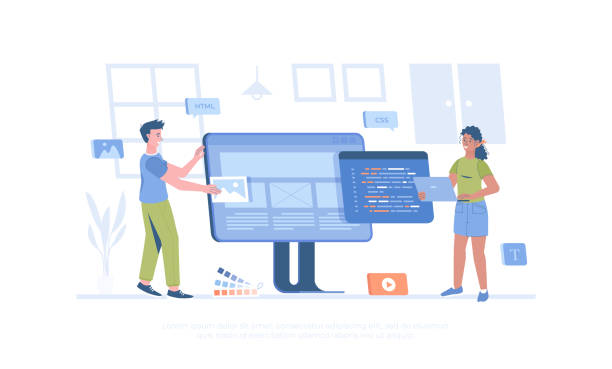
One of the main pillars of success in e-commerce website design is providing excellent customer support services and efficient order management.
Online customers expect a seamless and trouble-free experience at every stage of the purchase process, from entering the site to receiving the product.
Therefore, investing in customer support is as important as investing in marketing and website optimization.
The availability of multiple and accessible communication channels, such as online chat, phone number, and email, reassures customers that they can easily contact you if any questions or issues arise.
Quick and professional responses to customer questions, complaints, and suggestions not only increase their satisfaction but can also help resolve issues before they escalate.
A clear and fair return and refund policy is also a significant factor in building customer trust.
These policies should be clearly stated on your website so that customers are aware of the terms before making a purchase.
Alongside support, efficient order management is also crucial.
This includes processes for receiving orders, payment processing, packaging, shipping, and delivery tracking.
Using automated systems for inventory management and notifying customers about order status can significantly increase efficiency and reduce human errors.
Timely notifications via email or SMS about various order stages, from purchase confirmation to tracking code and estimated delivery time, improves the customer experience and reduces anxiety caused by waiting.
A strong order management system and unparalleled customer support will not only help retain existing customers but can also turn them into advocates and promoters of your brand.
Is your company’s website as professional and trustworthy as it should be? With specialized corporate website design by Rasaweb, create an online presence that reflects your credibility and attracts more customers.
✅ Build a powerful and professional image for your brand
✅ Convert visitors into real customers
⚡ Get a free consultation now!
Data Analysis and Continuous Store Performance Optimization
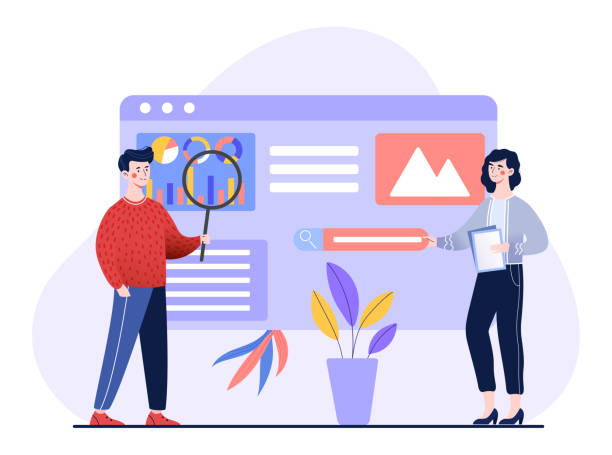
After launching and designing your e-commerce website, your work has just begun.
To ensure sustainable success and business growth, continuous data analysis and website performance optimization are vital necessities.
Analytics tools like Google Analytics and similar tools provide a wealth of valuable information about visitor behavior.
By analyzing this data, you can find answers to important questions: Where do your customers come from? What do they do on your site? Which pages do they view most, and where do they leave the site? What is your conversion rate, and what is the bounce rate of different pages? Understanding these metrics helps you identify the strengths and weaknesses of your online store.
For example, if the bounce rate of a specific product page is high, it might indicate flaws in product descriptions, low image quality, or unattractive pricing.
With careful analysis, you can formulate hypotheses and then implement small but targeted changes using A/B Testing.
A/B testing allows you to show two different versions of a page, button, or text to different groups of users and measure their performance to choose the best version.
This continuous and iterative optimization process enables you to improve the user experience, increase conversion rates, and ultimately maximize profitability.
Additionally, tracking the performance of marketing campaigns and their Return on Investment (ROI) is also highly important.
Data-driven decision-making, instead of guesswork, allows you to allocate your resources more effectively and adjust your strategies based on market realities and customer behavior.
This cycle of analysis, testing, and optimization is an unending process that will guarantee the long-term success of your online store.
The Future of E-commerce Website Design and Emerging Trends
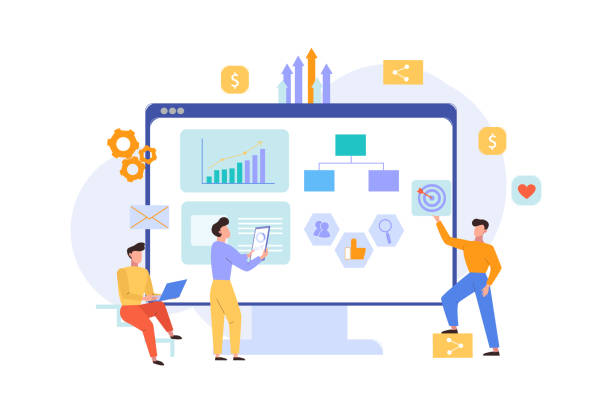
The world of e-commerce website design is constantly evolving, and every year we witness the emergence of new trends that transform the online shopping experience.
Anticipating and adapting to these trends is essential for maintaining competitiveness and future success.
One of the most important future trends is the role of Artificial Intelligence (AI) in e-commerce.
AI can significantly personalize the shopping experience, from product recommendations based on purchase and search history to advanced chatbots for customer support.
This technology helps businesses gain a deeper understanding of their customers and anticipate their needs.
Augmented Reality (AR) is also changing how customers interact with products.
Using AR, customers can “try on” products in their real environment before purchasing, for example, seeing clothes on themselves or placing furniture in their home space.
This technology significantly helps reduce return rates and increase customer trust.
Voice Commerce is also growing with the increased use of voice assistants like Siri and Alexa.
E-commerce websites should be optimized to respond to voice commands so that customers can easily shop by voice.
Sustainability and corporate social responsibility have also become important factors in customers’ purchasing decisions.
Online stores that prioritize environmental and social issues will have a significant competitive advantage.
Finally, personalization goes beyond product recommendations and includes providing fully customized shopping experiences based on each user’s preferences and behavior.
These trends indicate that the future of e-commerce website design is moving towards becoming smarter, more interactive, and more customer-centric.
Preparing for these changes is key to maintaining market position and growth in the competitive market of the future.
Frequently Asked Questions
| Question | Answer |
|---|---|
| What is e-commerce website design? | The process of building and developing a website for selling products or services online. This includes user interface design, user experience, implementation of content management systems, payment gateways, and inventory and order management. |
| What features should a good e-commerce website have? | Excellent user interface and user experience, high loading speed, strong security (especially for payments), attractive and complete product display, advanced search and filter capabilities, easy and fast shopping cart and checkout process, mobile compatibility (responsive), and customer support. |
| What platforms can be used for e-commerce website design? | Various platforms are available, such as WooCommerce (on WordPress), Shopify, Magento, PrestaShop, or even custom systems developed by design companies. The choice of platform depends on the needs, budget, and business volume. |
| How important is SEO in e-commerce website design? | SEO is extremely important for e-commerce websites. SEO helps your products and site pages achieve better rankings in Google and other search engine results and attract more targeted traffic, which directly leads to increased sales. |
| What is the cost of e-commerce website design? | The cost varies depending on several factors such as design complexity, required features, platform choice (ready-made or custom), product volume, and additional services like SEO and support. It can range from a few million Tomans for simpler sites with ready-made templates to tens or even hundreds of millions of Tomans for large and custom sites. |
And other advertising services from Rasaweb Advertising Agency
Smart Conversion Rate Optimization: A specialized service for growing customer acquisition based on precise audience targeting.
Smart Link Building: Professional optimization to increase website traffic using intelligent data analysis.
Smart Website Development: A professional solution to improve SEO ranking with a focus on Google Ads management.
Smart Advertorials: A novel service to increase website traffic through optimizing key pages.
Smart Marketplace: An effective tool for analyzing customer behavior with the help of user experience customization.
And over hundreds of other services in the field of internet advertising, advertising consultation, and organizational solutions
Internet Advertising | Advertising Strategy | Advertorial
Resources
- Comprehensive Guide to E-commerce Website Design
- Online Store Setup Tutorial
- Key Tips for a Successful Online Shop
- E-commerce Website Design Steps
✅
? Elevate your business with Rasaweb Afarin Digital Marketing Agency services! At Rasaweb Afarin, we specialize in providing comprehensive digital solutions for your business growth and development. From professional website design and SEO to social media management and targeted advertising campaigns, we provide everything you need to be seen and succeed in the online space.
📍 Tehran, Mirdamad Street, next to Bank Markazi, Kazeroun South Alley, Ramin Alley, No. 6

